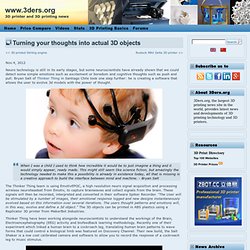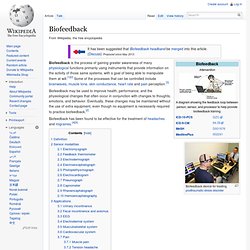

Turning your thoughts into actual 3D objects. Nov.4, 2012 Neuro technology is still in its early stages, but some neuroscientists have already shown that we could detect some simple emotions such as excitement or boredom and cognitive thoughts such as push and pull.

Bryan Salt of Thinker Thing in Santiago Chile took one step further: he is creating a software that allows the user to evolve 3d models with the power of thought. When I was a child I used to think how incredible it would be to just imagine a thing and it would simply appear, ready made. This might still seem like science fiction, but amazingly the technology needed to make this a possibility is already in existence today, all that is missing is a creative approach to build the interface between mind and machine. - Bryan Salt The Thinker Thing team is using EmotivEPOC, a high resolution neuro signal acquisition and processing wireless neuroheadset from Emotiv, to capture brainwaves and collect signals from the brain. (Salt Shaker) (Software) Check out the video below. Neuroduino. E-Health Sensor Platform for Arduino and Raspberry Pi [Biometric / Medical Applications] This information can be used to monitor in real time the state of a patient or to get sensitive data in order to be subsequently analysed for medical diagnosis.
![e-Health Sensor Platform for Arduino and Raspberry Pi [Biometric / Medical Applications]](http://cdn.pearltrees.com/s/pic/th/raspberry-applications-125034638)
Biometric information gathered can be wirelessly sent using any of the 6 connectivity options available: Wi-Fi, 3G, GPRS, Bluetooth, 802.15.4 and ZigBee depending on the application. If real time image diagnosis is needed a camera can be attached to the 3G module in order to send photos and videos of the patient to a medical diagnosis center. Data can be sent to the Cloud in order to perform permanent storage or visualized in real time by sending the data directly to a laptop or Smartphone. iPhone and Android applications have been designed in order to easily see the patient's information.
Pulse and Oxygen in Blood (SPO2) SPO2 sensor features Pulse oximetry a noninvasive method of indicating the arterial oxygen saturation of functional hemoglobin. Connecting the sensor Connect the module in the e-Health sensor platform. Initializing by. A Touchless 3D Tracking Interface. A Touchless 3D Tracking Interface. Books - Open SoftWear - SKU: MCI-LIB-01184. Biofeedback. Biofeedback is the process of gaining greater awareness of many physiological functions primarily using instruments that provide information on the activity of those same systems, with a goal of being able to manipulate them at will.[1][2] Some of the processes that can be controlled include brainwaves, muscle tone, skin conductance, heart rate and pain perception.[3] Biofeedback may be used to improve health, performance, and the physiological changes that often occur in conjunction with changes to thoughts, emotions, and behavior.

Eventually, these changes may be maintained without the use of extra equipment, even though no equipment is necessarily required to practice biofeedback.[2] Biofeedback has been found to be effective for the treatment of headaches and migraines.[4][5] Definition[edit] Sensor modalities[edit] Electromyograph[edit] The "Muscle Whistler", shown here with surface EMG electrodes, was an early biofeedback device[6] Feedback thermometer[edit] Electrodermograph[edit]
Development Boards - EKG-EMG Shield - SKU: MCI-TDD-00990. Micoach CONNECT Heart Rate Monitor for iPhone.